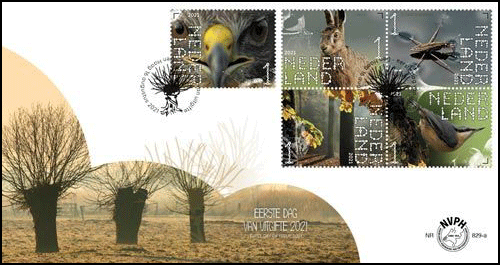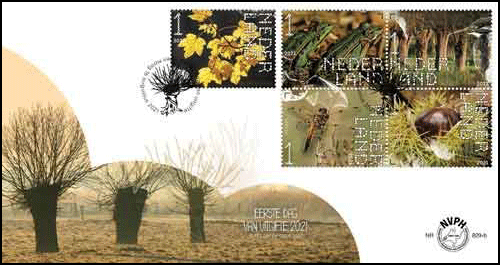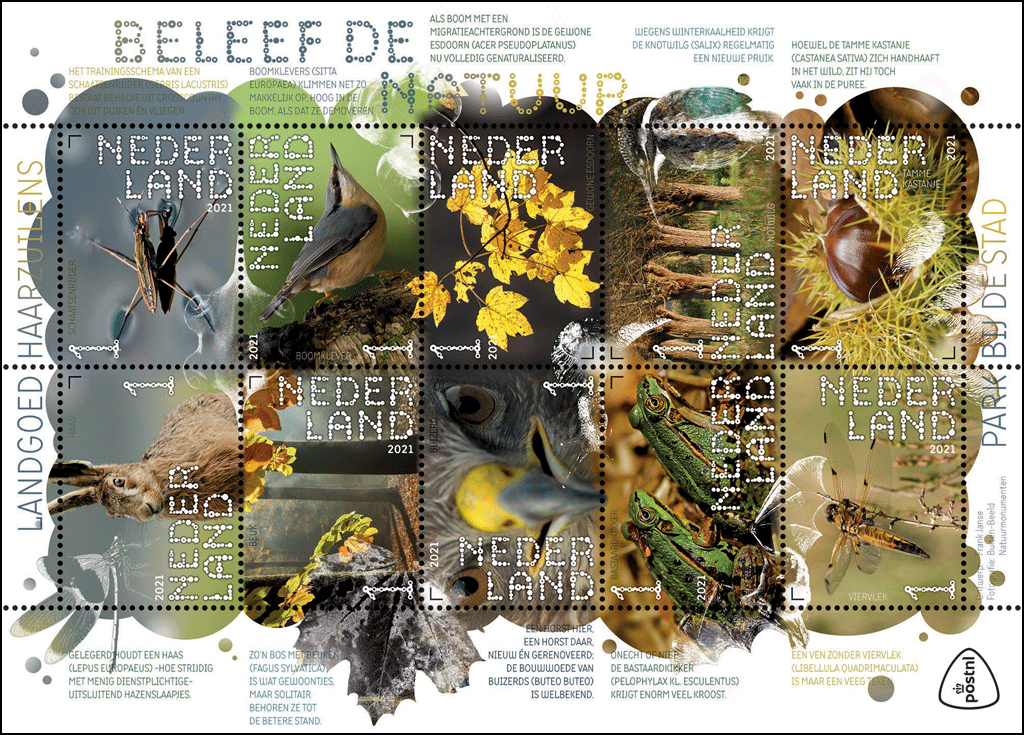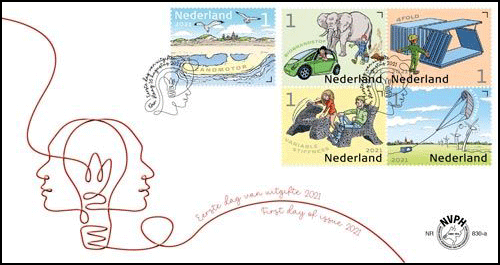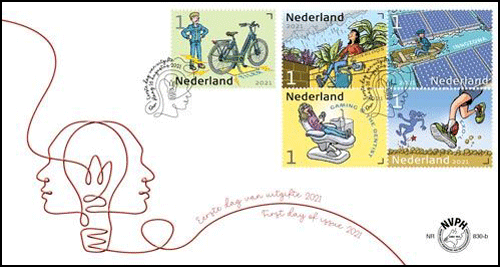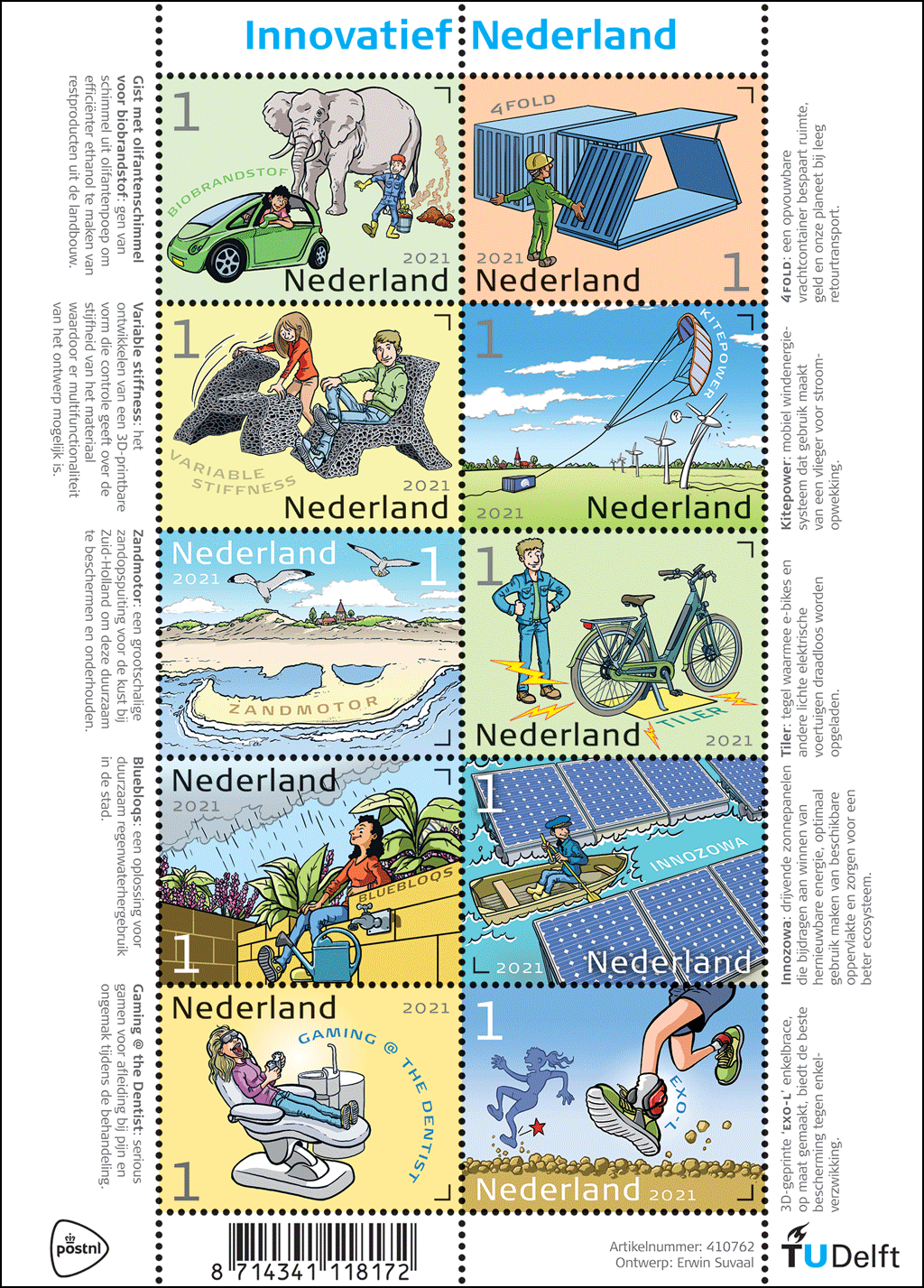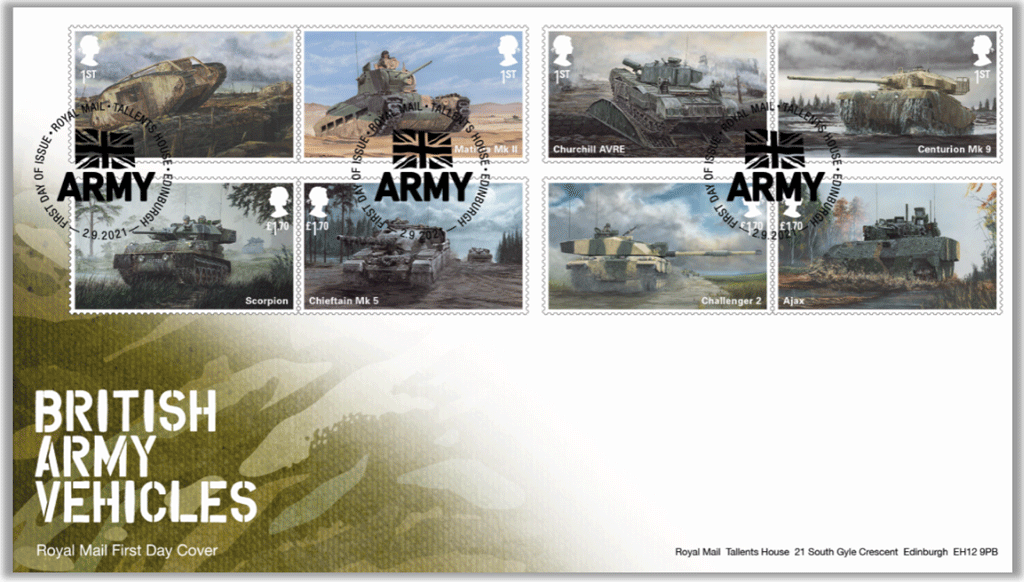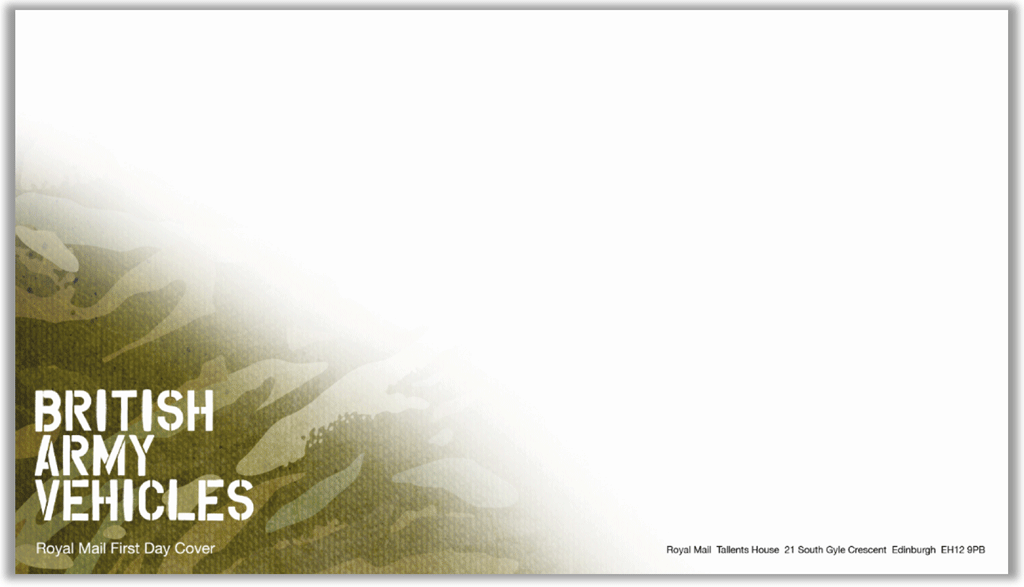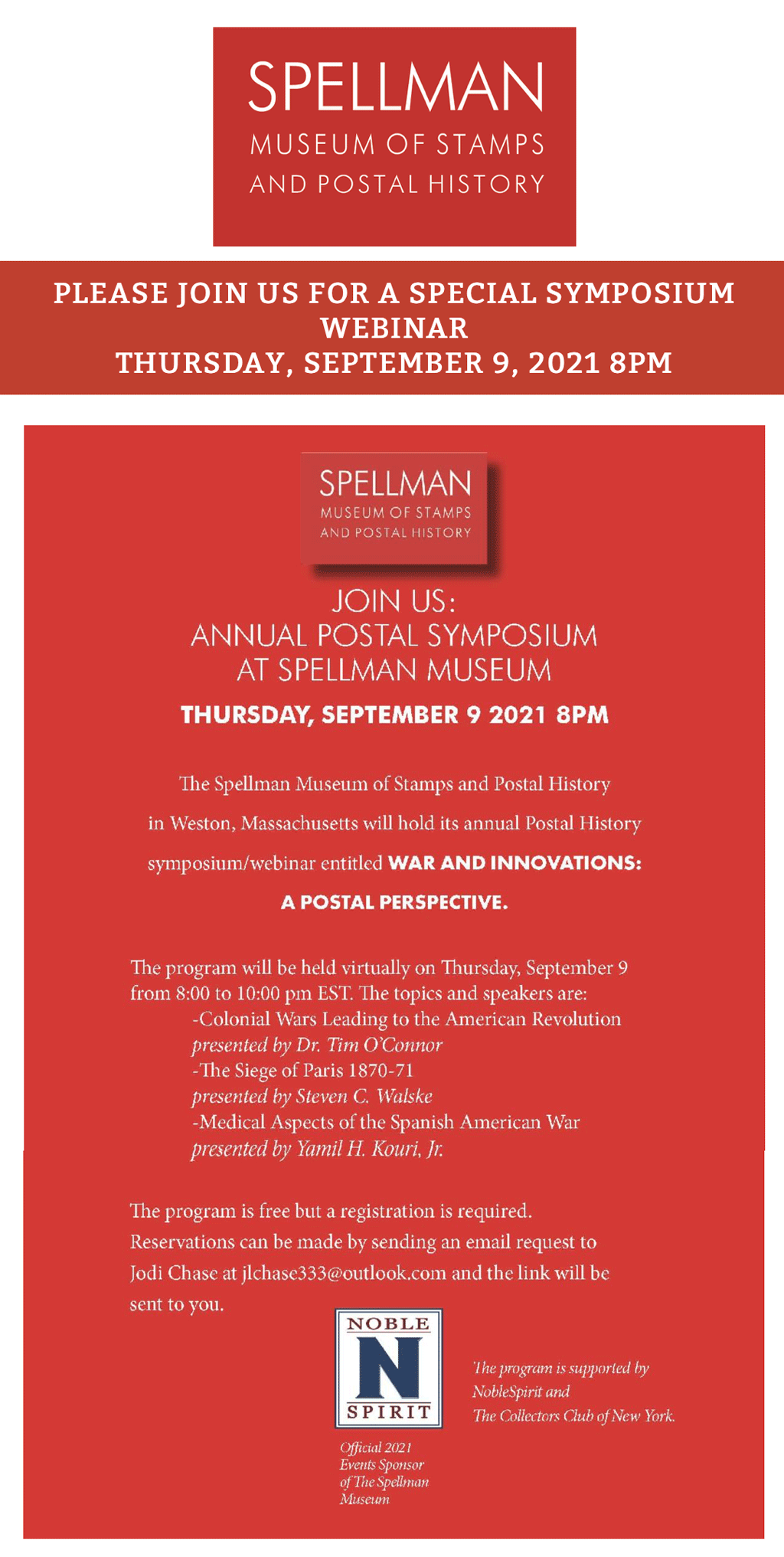 RSVP Jodi Chase to receive the registration link.
RSVP Jodi Chase to receive the registration link.
Monthly Archives: August 2021
U.S. National Postal Museum Reopens
[press release]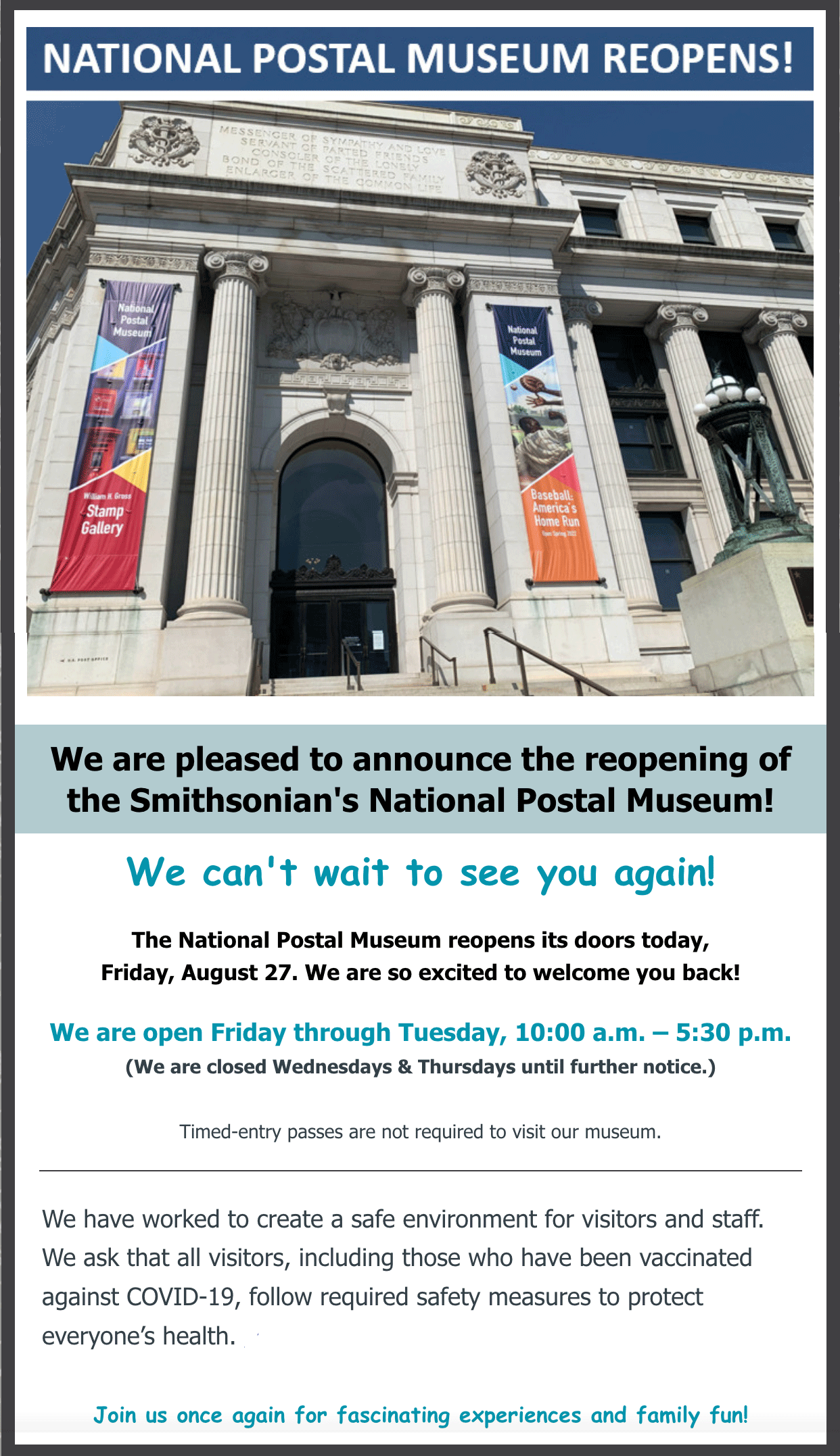 Click here for more information.
Click here for more information.
Experience Nature: Haarzuilens (Netherlands 2020)
[press release]
Cultural landscape Haarzuilens on stamps
Date of Issue: 16 August
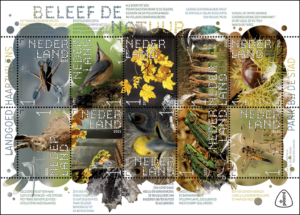 West of the city of Utrecht is the Haarzuilens estate, with the fairytale castle De Haar in the middle. The lands around the castle are owned by Natuurmonumenten [Natural Monuments]. The latest PostNL stamps from the Experience nature series feature the flora and fauna of this cultural landscape. The issue about the Haarzuilens estate is the last in the series Experience nature from 2021. Earlier this year, stamps were published about the Dwingelderveld heathland in Drenthe, the De Onlanden marsh landscape near the city of Groningen and the Duin en Kruidberg dune area in North Holland.
West of the city of Utrecht is the Haarzuilens estate, with the fairytale castle De Haar in the middle. The lands around the castle are owned by Natuurmonumenten [Natural Monuments]. The latest PostNL stamps from the Experience nature series feature the flora and fauna of this cultural landscape. The issue about the Haarzuilens estate is the last in the series Experience nature from 2021. Earlier this year, stamps were published about the Dwingelderveld heathland in Drenthe, the De Onlanden marsh landscape near the city of Groningen and the Duin en Kruidberg dune area in North Holland.
Reintroduction of old crops
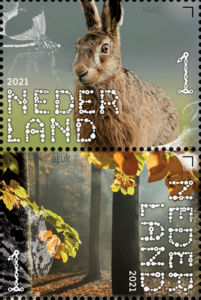 Landgoed Haarzuilens is a versatile cultural landscape, with flower-filled meadows, extensive fields, forests, farms, orchards, vegetable gardens, ditches, a duck decoy and even an apartment building for swallows. Natuurmonumenten brings the cultural history to life here by reintroducing old crops such as buckwheat, oats, alfalfa, rye and flax.
Landgoed Haarzuilens is a versatile cultural landscape, with flower-filled meadows, extensive fields, forests, farms, orchards, vegetable gardens, ditches, a duck decoy and even an apartment building for swallows. Natuurmonumenten brings the cultural history to life here by reintroducing old crops such as buckwheat, oats, alfalfa, rye and flax.
Character determines choice
All kinds of residents of the Haarzuilens estate make their appearance on the stamps. The character of the area, with fields, meadows, water and forests, is reflected in the selection of the flora and fauna depicted. From the pollard willows on the banks of the ditches, the frogs in the water and the insects that buzz around them. The buzzard and nuthatch make their appearance, as does the hare, the symbol of nature on the Haarzuilens estate.
Autumn is coming
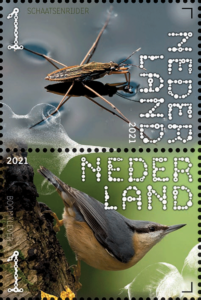 The stamp sheetlet about Haarzuilens is a design by graphic designer Frank Janse from Gouda. The atmosphere of the stamps refers to the arrival of autumn, with dark yellow, grey-green and blue-purple colours. The chosen photos were also taken in the autumn, when the chestnuts fall to the ground, the beech forest is steaming and the wings of the maple flutter down.
The stamp sheetlet about Haarzuilens is a design by graphic designer Frank Janse from Gouda. The atmosphere of the stamps refers to the arrival of autumn, with dark yellow, grey-green and blue-purple colours. The chosen photos were also taken in the autumn, when the chestnuts fall to the ground, the beech forest is steaming and the wings of the maple flutter down.
Layout in balance
In the distribution of the plants and animals on the stamp sheetlet, Janse has striven for an overall picture that is as beautiful and balanced as possible. This was done, according to the designer, “by combining detail and total shots, by different viewing directions of the animals and by also making diagonal connections. For example, between the two insects on the stamp sheetlet: the speed skater at the top right and the four-spot at the bottom left.”
Availability
The stamp sheetlet Experience nature – Haarzuilens estate has 10 different stamps with the value indication Nederland 1, intended for mail up to and including 20 grams with a destination within the Netherlands. The stamps will be available from August 16, 2021 at all PostNL sales points, the Bruna stores and via the website [direct link]. The stamps can also be ordered by telephone from Collect Club’s customer service on 088 – 868 99 00. The validity period is indefinite.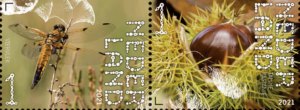
[In de Nederlandse taal]
Cultuurlandschap Haarzuilens op postzegels
Uitgiftedatum: 16 August
 Ten westen van de stad Utrecht ligt landgoed Haarzuilens, met in het midden het sprookjesachtige kasteel De Haar. De landerijen rondom het kasteel zijn eigendom van Natuurmonumenten. Op de nieuwste postzegels van PostNL uit de serie Beleef de natuur is de hoofdrol weggelegd voor de flora en fauna van dit cultuurlandschap.
Ten westen van de stad Utrecht ligt landgoed Haarzuilens, met in het midden het sprookjesachtige kasteel De Haar. De landerijen rondom het kasteel zijn eigendom van Natuurmonumenten. Op de nieuwste postzegels van PostNL uit de serie Beleef de natuur is de hoofdrol weggelegd voor de flora en fauna van dit cultuurlandschap.
De uitgifte over landgoed Haarzuilens is de laatste uit de serie Beleef de natuur van 2021. Eerder dit jaar verschenen postzegels over het heidegebied Dwingelderveld in Drenthe, het moeraslandschap De Onlanden bij de stad Groningen en het duingebied Duin en Kruidberg in Noord-Holland.
Herintroductie oude gewassen
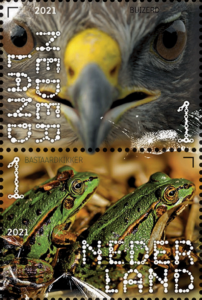 Landgoed Haarzuilens is een veelzijdig cultuurlandschap, met bloemrijke weides, uitgestrekte akkers, bossen, boerderijen, boomgaarden, moestuinen, slootjes, een eendenkooi en zelfs een flatgebouw voor zwaluwen. Natuurmonumenten brengt hier de cultuurhistorie tot leven door de herintroductie van oude gewassen als boekweit, haver, luzerne, rogge en vlas.
Landgoed Haarzuilens is een veelzijdig cultuurlandschap, met bloemrijke weides, uitgestrekte akkers, bossen, boerderijen, boomgaarden, moestuinen, slootjes, een eendenkooi en zelfs een flatgebouw voor zwaluwen. Natuurmonumenten brengt hier de cultuurhistorie tot leven door de herintroductie van oude gewassen als boekweit, haver, luzerne, rogge en vlas.
Karakter bepaalt keuze
Op de postzegels maken allerlei bewoners van landgoed Haarzuilens hun opwachting. Het karakter van het gebied, met akkers, weiden, water en bossen, keert terug in de selectie van de afgebeelde flora en fauna. Van de knotwilgen aan de oever van de sloten, de kikkers in het water en de insecten die eromheen zoemen. De buizerd en boomklever maken hun opwachting, net zoals de haas, hét symbool van de natuur van landgoed Haarzuilens.
Het najaar is aanstaande
Het postzegelvel over Haarzuilens is een ontwerp van grafisch ontwerper Frank Janse uit 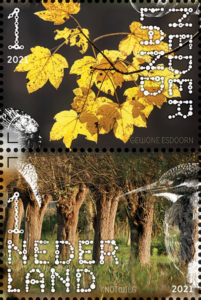 Gouda. De sfeer van de postzegels verwijst naar de komst van het najaar, met donkergele, grijsgroene en blauwpaarse kleuren. Ook de gekozen foto’s zijn in de herfst gemaakt, als de kastanjes op de grond vallen, het beukenbos dampt en de vleugeltjes van de esdoorn naar beneden dwarrelen.
Gouda. De sfeer van de postzegels verwijst naar de komst van het najaar, met donkergele, grijsgroene en blauwpaarse kleuren. Ook de gekozen foto’s zijn in de herfst gemaakt, als de kastanjes op de grond vallen, het beukenbos dampt en de vleugeltjes van de esdoorn naar beneden dwarrelen.
Indeling in balans
Bij de verdeling van de planten en dieren op het postzegelvel heeft Janse een zo mooi en gebalanceerd mogelijk totaalbeeld nagestreefd. Dat is gebeurd, aldus de ontwerper, “door combinaties van detail- en totaalopnames, door verschillende kijkrichtingen van de dieren en door ook diagonale verbanden te leggen. Bijvoorbeeld tussen de twee insecten op het postzegelvel: de schaatsenrijder rechtsboven en de viervlek linksonder.”
Verkrijgbaarheid
Het postzegelvel Beleef de natuur – landgoed Haarzuilens telt 10 verschillende postzegels met de waardeaanduiding Nederland 1, bedoeld voor post tot en met 20 gram met een bestemming binnen Nederland. De postzegels zijn vanaf 16 augustus 2021 verkrijgbaar bij alle verkooppunten van PostNL, de Bruna-winkels en via de website. De postzegels zijn ook telefonisch te bestellen bij de klantenservice van Collect Club op telefoonnummer 088 – 868 99 00. De geldigheidstermijn is onbepaald.
Innovative Netherlands (Netherlands 2021)
[press release]
PostNL illustrates how the Netherlands innovates
Issue date: 16 August
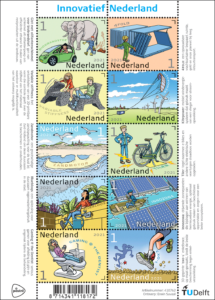 A new PostNL stamp sheetlet focuses on the innovative capacity of our country. The illustrations on the stamps refer to various innovations, developed by scientists at TU Delft, the largest and oldest technical university in our country. The Netherlands occupies a leading position internationally when it comes to innovative capacity. In the European Union, our country is in the top 5, worldwide we are in the top 10. The high score is partly due to the intensive public-private partnership between knowledge institutions, governments and the business community.
A new PostNL stamp sheetlet focuses on the innovative capacity of our country. The illustrations on the stamps refer to various innovations, developed by scientists at TU Delft, the largest and oldest technical university in our country. The Netherlands occupies a leading position internationally when it comes to innovative capacity. In the European Union, our country is in the top 5, worldwide we are in the top 10. The high score is partly due to the intensive public-private partnership between knowledge institutions, governments and the business community.
Summer
Each of the 10 stamps of the Innovative Netherlands stamp sheet has a cheerful illustration about a special innovation project at TU 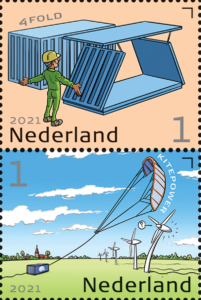 Delft. The illustrations were made by cartoonist and cartoonist Erwin Suvaal from Rijsbergen. The summery colored drawings show the essence and the application of each innovation with a wink.
Delft. The illustrations were made by cartoonist and cartoonist Erwin Suvaal from Rijsbergen. The summery colored drawings show the essence and the application of each innovation with a wink.
Airy
On the small footprint of the stamps, Suvaal has managed to bring something light to each illustration. He does this by first selecting the elements that are necessary to understand the innovation. “For example, solar energy on inland waterways involves water and solar panels,” says Suvaal. “So you can’t get around that. But I draw something to make it come alive. For example, by emphasizing the water with a man in a boat rowing between the solar panels.”
Stages of innovation
The stamps show that the innovations are being applied in all kinds of areas, ranging from 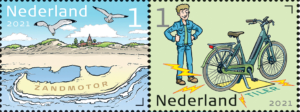 energy saving projects, smart transport solutions and flexible production options to effective water management and innovations in healthcare. The selection takes into account the stages that an innovation goes through. For example, there are inventions that are still in a prototype phase, other innovations are currently being extensively tested and others are in full production.
energy saving projects, smart transport solutions and flexible production options to effective water management and innovations in healthcare. The selection takes into account the stages that an innovation goes through. For example, there are inventions that are still in a prototype phase, other innovations are currently being extensively tested and others are in full production.
Innovations through collaboration
In addition to leading-edge education and research, TU Delft is fully committed to 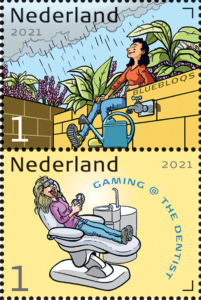 innovation. An important breeding ground for this is the TU Delft Campus: a unique ecosystem with more than 250 companies, start-ups, research institutes and field labs, with the university as the beating heart. Paul Althuis, Director TU Delft Innovation & Impact Center: “We strongly believe in collaboration between science and partners to accelerate innovations and provide solutions to current challenges in society. We are proud that these innovations are now on a postage stamp and are thus passed around the world.”
innovation. An important breeding ground for this is the TU Delft Campus: a unique ecosystem with more than 250 companies, start-ups, research institutes and field labs, with the university as the beating heart. Paul Althuis, Director TU Delft Innovation & Impact Center: “We strongly believe in collaboration between science and partners to accelerate innovations and provide solutions to current challenges in society. We are proud that these innovations are now on a postage stamp and are thus passed around the world.”
Availability
The Innovative Netherlands stamp sheet has 10 different stamps with the value indication Nederland 1, intended for mail up to and including 20 grams with a destination within the Netherlands. The stamps will be available from August 16, 2021 at the Bruna stores and via the website [direct link here]. The stamps can also be ordered by telephone from Collect Club’s customer service on 088 – 868 99 00. The validity period is indefinite.
[In de Nederlandse taal]
PostNL illustreert hoe Nederland innoveert
Uitgiftedatum: 16 augustus
 Een nieuwe postzegelvel van PostNL gaat alle aandacht uit naar het innovatieve vermogen van ons land. De illustraties op de postzegels verwijzen naar uiteenlopende innovaties, ontwikkeld door wetenschappers van de TU Delft, de grootste en oudste technische universiteit van ons land.
Een nieuwe postzegelvel van PostNL gaat alle aandacht uit naar het innovatieve vermogen van ons land. De illustraties op de postzegels verwijzen naar uiteenlopende innovaties, ontwikkeld door wetenschappers van de TU Delft, de grootste en oudste technische universiteit van ons land.
Nederland neemt internationaal een vooraanstaande positie in als het om innovatief vermogen gaat. In de Europese Unie behoort ons land tot de top 5, wereldwijd zitten we in de top 10. De hoge score is onder meer te danken aan de intensieve publiek-private samenwerking tussen kennisinstellingen, overheden en bedrijfsleven.
Zomers
Op elk van de 10 postzegels van het postzegelvel Innovatief Nederland staat een vrolijke illustratie over een bijzonder innovatieproject van de TU Delft. De illustraties zijn gemaakt 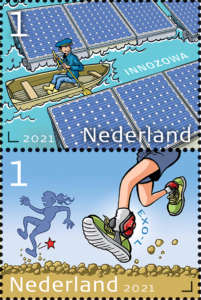 door cartoonist en striptekenaar Erwin Suvaal uit Rijsbergen. De zomers gekleurde tekeningen laten met een knipoog de essentie en de toepassing van iedere innovatie zien.
door cartoonist en striptekenaar Erwin Suvaal uit Rijsbergen. De zomers gekleurde tekeningen laten met een knipoog de essentie en de toepassing van iedere innovatie zien.
Luchtig
Op het kleine oppervlak van de postzegels is Suvaal erin geslaagd in elke illustratie iets luchtigs te brengen. Dat doet hij door eerst de elementen te selecteren die nodig zijn om de innovatie te kunnen begrijpen. “Bij de zonne-energie op de binnenwateren bijvoorbeeld gaat het om water en om zonnepanelen”, aldus Suvaal. “Dus daar kun je niet omheen. Maar ik teken er iets bij waardoor het tot leven komt. Door bijvoorbeeld het water te benadrukken met een man in een bootje die tussen de zonnepanelen door roeit.”
Stadia van innovatie
De postzegels laten zien dat de innovaties op allerlei gebieden worden toegepast, 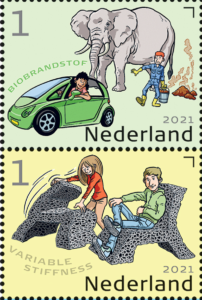 uiteenlopend van energiebesparingsprojecten, slimme transportoplossingen en flexibele productiemogelijkheden tot effectief watermanagement en vernieuwingen in de gezondheidszorg. In de selectie is rekening gehouden met de stadia die een innovatie doorloopt. Zo zijn er uitvindingen die zich nog in een prototypefase bevinden, worden andere innovaties op dit moment uitgebreid getest en zijn weer andere volop in productie.
uiteenlopend van energiebesparingsprojecten, slimme transportoplossingen en flexibele productiemogelijkheden tot effectief watermanagement en vernieuwingen in de gezondheidszorg. In de selectie is rekening gehouden met de stadia die een innovatie doorloopt. Zo zijn er uitvindingen die zich nog in een prototypefase bevinden, worden andere innovaties op dit moment uitgebreid getest en zijn weer andere volop in productie.
Innovaties door samenwerking
Naast toonaangevend onderwijs en onderzoek zet de TU Delft vol in op innovatie. Een belangrijke broedplaats daarvoor is de TU Delft Campus: een uniek ecosysteem met meer dan 250 bedrijven, startups, onderzoeksinstituten en fieldlabs, met de universiteit als kloppend hart. Paul Althuis, Directeur TU Delft Innovation &  Impact Centre: “We geloven sterk in de samenwerking tussen wetenschap en partners om innovaties te versnellen en oplossingen te bieden voor actuele uitdagingen in de samenleving. We zijn er trots op dat deze innovaties nu op een postzegel staan en zo de wereld overgaan.”
Impact Centre: “We geloven sterk in de samenwerking tussen wetenschap en partners om innovaties te versnellen en oplossingen te bieden voor actuele uitdagingen in de samenleving. We zijn er trots op dat deze innovaties nu op een postzegel staan en zo de wereld overgaan.”
Verkrijgbaarheid
Het postzegelvel Innovatief Nederland telt 10 verschillende postzegels met de waardeaanduiding Nederland 1, bedoeld voor post tot en met 20 gram met een bestemming binnen Nederland. De postzegels zijn vanaf 16 augustus 2021 verkrijgbaar bij de Bruna-winkels en via de website. De postzegels zijn ook telefonisch te bestellen bij de klantenservice van Collect Club op telefoonnummer 088 – 868 99 00. De geldigheidstermijn is onbepaald.
British Army Vehicles (UK 2021)
Issue Date: 2nd Sept 2021
 [press release]
[press release]
Royal Mail Issues 12 Special Stamps that Illustrate the Development of British Army Vehicles over The Decades
- The stamp set features stunning paintings of eight British Army Armoured Vehicles including Main Battle Tanks from across the decades.
- Seven of the eight stamps in the main set were painted exclusively for Royal Mail, by ex- Battle Tank crewman, turned military artist, Mick Graham.
- A further four stamps, presented in a miniature sheet, include a range of specialist support and patrol vehicles used by the British Army.
- Royal Mail worked closely with the Ministry of Defence on the stamp issue.
- The full set of 12 stamps, available in a Presentation Pack, retails at £16.20. The stamps and a range of collectible products are available at www.royalmail.com/britisharmyvehicles and go on general sale from 2 September 2021.
Royal Mail has revealed images of 12 Special Stamps that illustrate the development of British Army Vehicles over the decades.
Included are eight images featuring stunning paintings of important British Army Armoured Vehicles illustrated in action through the years since the First World War.
Seven of the eight stamps in the main set were exclusively illustrated for Royal Mail by military artist Mick Graham. Mick Graham was part of the 4th Royal Tank Regiment, serving for fifteen years, including as a Gunnery Instructor on Chieftain Tanks before turning his hand to art.
The British Army has always needed vehicles to transport food, munitions and supplies to allow soldiers to carry out their operations. For centuries, this meant the horse and wagon.
At the start of the First World War, however, breaking through trenches defended by barbed wire and machine guns required new vehicles. An innovative experimental armoured vehicle with a petrol engine, a turret for armament and tracks to cross broken ground was commissioned and nicknamed ‘Little Willie’.
Whilst this vehicle never saw combat action the innovation and experimentation which were hallmarks of its development led to the construction of the first rhomboid-shaped tanks, 49 of which first fought in September 1916. By the end of the war, Britain had developed most of the types of armoured vehicles still in service today: tank, armoured personnel carrier, self-propelled artillery and an engineer vehicle.
On the day the First World War ended, a floating tank was being trialled. Between the two world wars, the Army experimented with a fully mechanised force, including tracked scout carriers, tanks, gun tugs and trucks to ferry troops – controlled via newly effective radios.
Despite the success of the trials, the financial depression of the 1930s and the emphasis on the Royal Navy and Royal Air Force as the first line of defence meant that mechanisation was slower than the Army wanted.
At the beginning of the Second World War, the Army had 40,000 vehicles – and was the only fully mechanised force in Europe. Armoured divisions played a crucial role in mobile warfare in Europe and North Africa; Britain started the war with two of these armoured divisions and finished with eleven. Britain’s own vehicle production was supplemented by tens of thousands of trucks, jeeps and tanks from the USA, and by 1945 there were over 1.5 million vehicles in service.
The Cold War brought new requirements for Army vehicles, such as for some to be sealed against chemical and nuclear contamination, and new technologies, such as infrared or thermal imaging, enabling night-time use.
Recent campaigns have led to a range of vehicles to help patrol and protect troops and supplies against all-round attack. New developments and experimentation with digital technology are leading to the increasing fielding of remotely controlled and autonomous vehicles.
Matt Parkes, Director of Stamps & Collectibles at Royal Mail said: “These are some of the most important vehicles that have served the British Army since the First World War. Their impact both in combat and the development of armoured vehicles cannot be underestimated – and it is for this reason we mark these vehicles with a set of Special Stamps.”
Royal Mail worked closely with the Ministry of Defence on the stamp issue.
Product range at a glance:
- Stamp set AS7600 £10.20
- Miniature Sheet MZ168 £5.10
- Presentation Pack AP496 £16.20
- First Day Cover Stamps AF477 £12.90
- First Day Cover Miniature Sheet MF164 £6.80
- Stamp Souvenir AW196 £12.90
- Stamp Sheet Souvenir AW197 £6.80
- First Day Envelope AE432 £0.30
- Postcards AQ312 £5.85
- British Army Vehicles Matilda Mk II Framed Gallery print with stamp N3263 £59.99
- British Army Vehicles Centurion Mk 9 Framed Gallery print with stamp N3264 £59.99
- British Army Vehicles Chieftain Mk 5 Framed Gallery print with stamp N3265 £59.99
- 1st Full Stamp Sheet – 48 AS7600AFS £40.80
- 1st Half Stamp Sheet – 24 AS7600AHS £20.40
- £1.70 Full Stamp Sheet – 48 AS7600BFS £81.60
- £1.70 Half Stamp Sheet – 24 AS7600BFS £40.80
Mk IV – 1st class
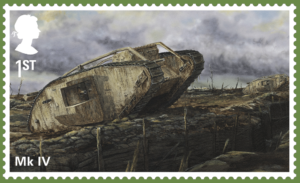 The first use of Mark I tanks on the Somme in September 1916 had mixed results, but British Commander-in-Chief General Douglas Haig saw their potential and ordered 1,000. The Mark II and III tanks were made in small quantities, but it was the Mark IV, with over 1,200 made, that saw the most use before the war’s end. Tanks were designated either ‘male’ or ‘female’, according to gun types fitted. The male Mark IV tanks had shorter six-pounder guns than on the Mark I, and the housings could be pushed into the vehicle to simplify rail movement. The eight-strong crews saw their tanks work well at the Battle of Messines in June 1917 but then flounder in mud at Passchendaele. Doubts were raised about the expense and usefulness of the tank, but the Mark IVs were to prove their worth in a mass attack by over 400 at Cambrai in November 1917.
The first use of Mark I tanks on the Somme in September 1916 had mixed results, but British Commander-in-Chief General Douglas Haig saw their potential and ordered 1,000. The Mark II and III tanks were made in small quantities, but it was the Mark IV, with over 1,200 made, that saw the most use before the war’s end. Tanks were designated either ‘male’ or ‘female’, according to gun types fitted. The male Mark IV tanks had shorter six-pounder guns than on the Mark I, and the housings could be pushed into the vehicle to simplify rail movement. The eight-strong crews saw their tanks work well at the Battle of Messines in June 1917 but then flounder in mud at Passchendaele. Doubts were raised about the expense and usefulness of the tank, but the Mark IVs were to prove their worth in a mass attack by over 400 at Cambrai in November 1917.
Matilda Mk II – 1st class
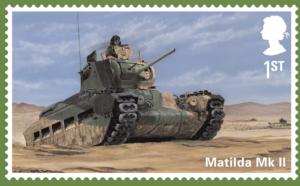 The A12 Infantry Tank, or Matilda, was the second in a series of infantry tanks that Britain put into production just before the Second World War. It was thought that three types of tank would be needed: small light tanks for reconnaissance, cruiser tanks to exploit breakthroughs and infantry tanks that would attack a defended position with the infantry. As they were more heavily armoured, infantry tanks were slower (9mph off-road), but this was considered adequate as they were to support infantry on foot. The Matilda II saw action in France in 1940, its thick armour making it impervious to the standard German 37mm anti-tank gun. Against Italian opposition in North Africa, the success of the Matilda led to it being called ‘The Queen of the Desert’. Its small turret prevented the fitting of a larger gun, so from 1942 the Matilda was relegated to use in the Far East, where the Japanese fi elded only lighter tanks.
The A12 Infantry Tank, or Matilda, was the second in a series of infantry tanks that Britain put into production just before the Second World War. It was thought that three types of tank would be needed: small light tanks for reconnaissance, cruiser tanks to exploit breakthroughs and infantry tanks that would attack a defended position with the infantry. As they were more heavily armoured, infantry tanks were slower (9mph off-road), but this was considered adequate as they were to support infantry on foot. The Matilda II saw action in France in 1940, its thick armour making it impervious to the standard German 37mm anti-tank gun. Against Italian opposition in North Africa, the success of the Matilda led to it being called ‘The Queen of the Desert’. Its small turret prevented the fitting of a larger gun, so from 1942 the Matilda was relegated to use in the Far East, where the Japanese fi elded only lighter tanks.
Churchill AVRE – 1st class
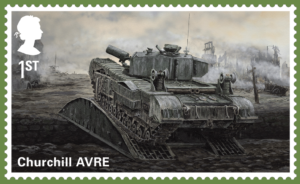 The costly failure of the raid at Dieppe in 1942 led a Canadian Royal Engineer Lieutenant JJ Denovan to propose a conversion of the Churchill infantry tank. In the turret, a spigot mortar, called the Petard, could fire a 40lb (18kg) demolition charge to a range of 200 yards. This would have a devastating effect on defensive structures or obstacles. Fixtures on the tank allowed it be adapted – to carry large loads or devices such as bobbin to lay trackway or demolition charges. The AVREs – Armoured Vehicles Royal Engineers – were issued to the 79th Armoured Division, 60 for each of three assault regiments, and they first went into action on D-Day (6 June 1944). Along with other specialised vehicles of the 79th Armoured Division, the AVREs were issued across Field Marshal Bernard Montgomery’s 21st Army Group in the North West Europe campaign, and they were considered a great success.
The costly failure of the raid at Dieppe in 1942 led a Canadian Royal Engineer Lieutenant JJ Denovan to propose a conversion of the Churchill infantry tank. In the turret, a spigot mortar, called the Petard, could fire a 40lb (18kg) demolition charge to a range of 200 yards. This would have a devastating effect on defensive structures or obstacles. Fixtures on the tank allowed it be adapted – to carry large loads or devices such as bobbin to lay trackway or demolition charges. The AVREs – Armoured Vehicles Royal Engineers – were issued to the 79th Armoured Division, 60 for each of three assault regiments, and they first went into action on D-Day (6 June 1944). Along with other specialised vehicles of the 79th Armoured Division, the AVREs were issued across Field Marshal Bernard Montgomery’s 21st Army Group in the North West Europe campaign, and they were considered a great success.
Centurion MK 9 – 1st class
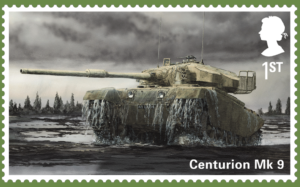 The Centurion was the British answer to the German Panther tank, developed in the Second World War. It missed seeing wartime action by a month but went on to have a long service life. The tank went through 13 marks (or models) in British Army service, showing an ability to be upgraded. It started with a 17-pounder gun, then a 20-pounder, followed by the very successful L7 105mm gun. The Rolls Royce Meteor engine gave the tank 650 horsepower – double that of most other wartime tanks. However, earlier models had a range of only 60 miles (97km), so a fuel mono-trailer was used until a larger internal tank was provided. The Mark 9 tank was an improved, rebuilt version of the Mark 7 with the L7 105mm fitted. This powerful gun became a NATO standard. The Centurion tank first saw action in the Korean War and was a huge export success, with some tanks still in service.
The Centurion was the British answer to the German Panther tank, developed in the Second World War. It missed seeing wartime action by a month but went on to have a long service life. The tank went through 13 marks (or models) in British Army service, showing an ability to be upgraded. It started with a 17-pounder gun, then a 20-pounder, followed by the very successful L7 105mm gun. The Rolls Royce Meteor engine gave the tank 650 horsepower – double that of most other wartime tanks. However, earlier models had a range of only 60 miles (97km), so a fuel mono-trailer was used until a larger internal tank was provided. The Mark 9 tank was an improved, rebuilt version of the Mark 7 with the L7 105mm fitted. This powerful gun became a NATO standard. The Centurion tank first saw action in the Korean War and was a huge export success, with some tanks still in service.
Scorpion – £1.70
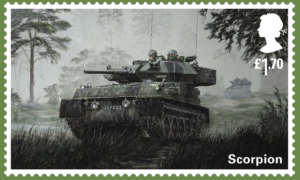 The Scorpion was part of a family of vehicles designed by Alvis in the 1960s around a number of common components. The 76mm low-velocity gun could fire a range of ammunition types and gave the small, light (8 tonnes) tank quite a punch. With aluminium armour (to keep weight down) and the Jaguar J60 4.2-litre petrol engine (the same as the E-type sports car), the tank’s top speed of 45mph made the Scorpion a difficult target to hit as a reconnaissance vehicle. Two Scorpions could fit inside a C-130 Hercules transport plane, and the original width specification was to allow it to pass through Malaysian rubber plantations. It was exported widely, and Scorpions are still in service. The vehicle saw action with the British Army in the Falklands conflict and in the First Gulf War before being withdrawn from service in 1994. Many remember the vehicle as the Action Man toy tank.
The Scorpion was part of a family of vehicles designed by Alvis in the 1960s around a number of common components. The 76mm low-velocity gun could fire a range of ammunition types and gave the small, light (8 tonnes) tank quite a punch. With aluminium armour (to keep weight down) and the Jaguar J60 4.2-litre petrol engine (the same as the E-type sports car), the tank’s top speed of 45mph made the Scorpion a difficult target to hit as a reconnaissance vehicle. Two Scorpions could fit inside a C-130 Hercules transport plane, and the original width specification was to allow it to pass through Malaysian rubber plantations. It was exported widely, and Scorpions are still in service. The vehicle saw action with the British Army in the Falklands conflict and in the First Gulf War before being withdrawn from service in 1994. Many remember the vehicle as the Action Man toy tank.
Chieftain Mk 5 – £1.70
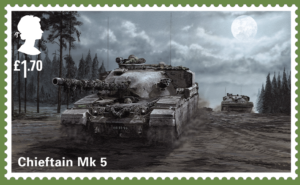 Britain decided that the priority for a main battle tank (MBT) in the Cold War was to have the best firepower and great protection; mobility was seen as less important. The stabilised 120mm gun was tremendously accurate compared to those of the wartime generation, and it was placed in a new style of mounting without a traditional mantlet (or shield). The driver had a semi-recumbent driving position, meaning that the hull could be lower, to present a smaller target. The steel armour was sloped to increase the level of protection, and additional ‘Stillbrew’ armour was added when the Soviets introduced the 125mm gun. However, the L60 engine had many reliability issues in service – a definite weakness of the tank. The tank was upgraded, running through 12 marks, after being introduced to the Army in 1967. It had some export success in the Middle East and left British service as a gun tank in the late 1990s.
Britain decided that the priority for a main battle tank (MBT) in the Cold War was to have the best firepower and great protection; mobility was seen as less important. The stabilised 120mm gun was tremendously accurate compared to those of the wartime generation, and it was placed in a new style of mounting without a traditional mantlet (or shield). The driver had a semi-recumbent driving position, meaning that the hull could be lower, to present a smaller target. The steel armour was sloped to increase the level of protection, and additional ‘Stillbrew’ armour was added when the Soviets introduced the 125mm gun. However, the L60 engine had many reliability issues in service – a definite weakness of the tank. The tank was upgraded, running through 12 marks, after being introduced to the Army in 1967. It had some export success in the Middle East and left British service as a gun tank in the late 1990s.
Challenger 2 – £1.70
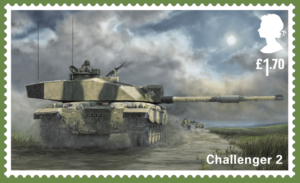 The Challenger 2 tank was initially started as a private venture by Vickers Defence, given that the Army saw the Challenger 1 (a design originally intended for the Shah of Iran) as only a stop-gap vehicle. The Challenger 2 was issued to regiments in 1998 after extensive testing. It has Chobham armour, a still-secret composite arrangement of material including ceramics that gives much greater protection than steel alone against modern weapons. When going into action, extra armour can be fitted to the tank, along with a range of other devices, such as electronic countermeasures. The Challenger 2 has a 120mm rifled gun that can fire a range of ammunition types and a thermal imaging system to allow it to fight at night. The Perkins diesel engine creates 1,200 horsepower. As with many tanks, the vehicle is being upgraded to respond to new threats and challenges on the modern battlefield.
The Challenger 2 tank was initially started as a private venture by Vickers Defence, given that the Army saw the Challenger 1 (a design originally intended for the Shah of Iran) as only a stop-gap vehicle. The Challenger 2 was issued to regiments in 1998 after extensive testing. It has Chobham armour, a still-secret composite arrangement of material including ceramics that gives much greater protection than steel alone against modern weapons. When going into action, extra armour can be fitted to the tank, along with a range of other devices, such as electronic countermeasures. The Challenger 2 has a 120mm rifled gun that can fire a range of ammunition types and a thermal imaging system to allow it to fight at night. The Perkins diesel engine creates 1,200 horsepower. As with many tanks, the vehicle is being upgraded to respond to new threats and challenges on the modern battlefield.
Ajax – £1.70
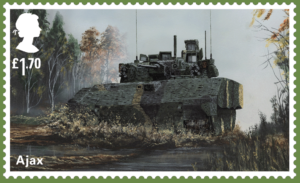 Ajax is the scouting vehicle in a new family of 589 medium-weight armoured vehicles just coming into service with the British Army. Using state-of-the-art digital technology, the Ajax has advanced intelligence, surveillance, target acquisition and reconnaissance (ISTAR) capabilities and can process and share digital information with other vehicles and higher formations. The Ajax has a turret mounting a new 40mm cased telescoped armament system (CTAS) that can fire a variety of ammunition types accurately on the move. The vehicle is protected by modular armour and a number of defensive systems to detect threats, one of which has acoustic shot detection sensors that can tell the crew the direction of incoming fire. The Ajax family consists of six variants based on a common chassis: Ajax (turreted, reconnaissance and strike vehicle), Ares (reconnaissance and armoured personnel carrier), Argus (engineer reconnaissance), Athena (command and control), Atlas (equipment support recovery) and Apollo (equipment repair).
Ajax is the scouting vehicle in a new family of 589 medium-weight armoured vehicles just coming into service with the British Army. Using state-of-the-art digital technology, the Ajax has advanced intelligence, surveillance, target acquisition and reconnaissance (ISTAR) capabilities and can process and share digital information with other vehicles and higher formations. The Ajax has a turret mounting a new 40mm cased telescoped armament system (CTAS) that can fire a variety of ammunition types accurately on the move. The vehicle is protected by modular armour and a number of defensive systems to detect threats, one of which has acoustic shot detection sensors that can tell the crew the direction of incoming fire. The Ajax family consists of six variants based on a common chassis: Ajax (turreted, reconnaissance and strike vehicle), Ares (reconnaissance and armoured personnel carrier), Argus (engineer reconnaissance), Athena (command and control), Atlas (equipment support recovery) and Apollo (equipment repair).
Stamps – Technical Details:
Number of stamps: 8
Value of Stamps: 4 x 1st and 4 x £1.70
(4 x Horizonal se-tenant pairs)
Illustrations: Mick Graham Art © Royal Mail Group Ltd 2021, except for Challenger 2 © Mick Graham Art
Design: Royal Mail Group Limited
Stamp Format: Landscape
Stamp Size: 50mm (w) x 30mm (h)
Printer : International Security Printers
Print Process: Lithography
Perforations: 14 x 14
Phosphor: Bars as appropriate
Gum: PVA
Miniature Sheet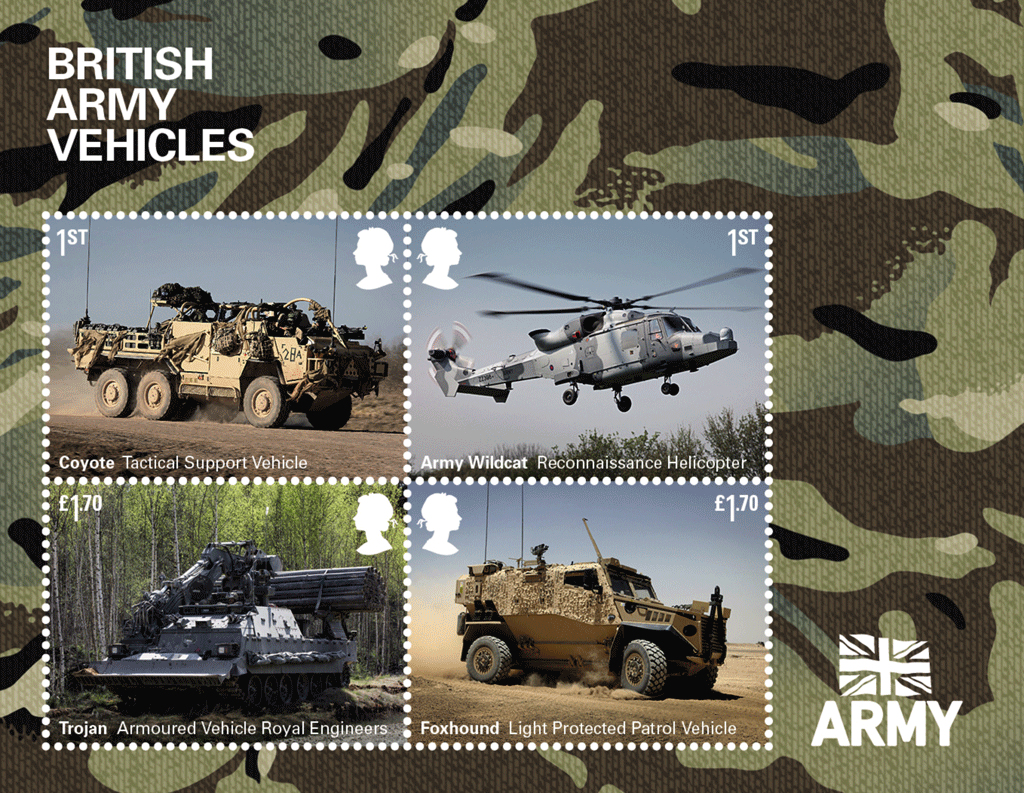 An additional four stamps featuring a range of non-combat vehicles used by the British Army
An additional four stamps featuring a range of non-combat vehicles used by the British Army
- 1st Class: Coyote (Tactical Support Vehicle)
- 1st Class: Army Wildcat (Reconnaissance Helicopter)
- £1.70: Trojan (Armoured Vehicle Royal Engineers)
- £1.70: Foxhound (Light Protected Patrol Vehicle)
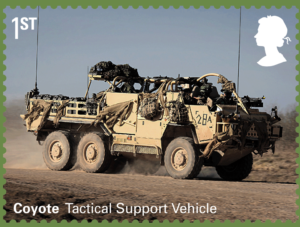 The Coyote Tactical Support Vehicle is based on the Jackal but has six wheels instead of four. The extra wheels allow it to carry a heavier load and up to five soldiers, and it can act as a support vehicle for the Jackal. The Jackal and Coyote have superb off-road capability and are used for reconnaissance and patrolling.
The Coyote Tactical Support Vehicle is based on the Jackal but has six wheels instead of four. The extra wheels allow it to carry a heavier load and up to five soldiers, and it can act as a support vehicle for the Jackal. The Jackal and Coyote have superb off-road capability and are used for reconnaissance and patrolling.
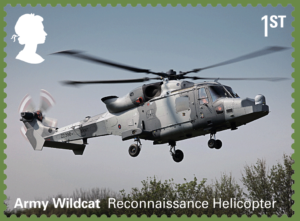 The Wildcat AH Mk 1 Reconnaissance Helicopter has a number of roles to fulfil for the Army (‘AH’ in this variant stands for ‘Army Helicopter’): airborne reconnaissance, command and control, transport of six troops or supplies, and the carrying of a sophisticated battlefield surveillance system. The Army ordered 34 Wildcats and the Royal Navy 28 in a slightly different configuration.
The Wildcat AH Mk 1 Reconnaissance Helicopter has a number of roles to fulfil for the Army (‘AH’ in this variant stands for ‘Army Helicopter’): airborne reconnaissance, command and control, transport of six troops or supplies, and the carrying of a sophisticated battlefield surveillance system. The Army ordered 34 Wildcats and the Royal Navy 28 in a slightly different configuration.
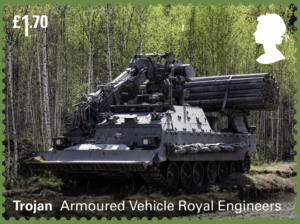 Trojan is an armoured engineer vehicle that is equipped to clear obstacles on the battlefield. It can have a dozer blade or a mine plough fitted to the front, has an excavator arm and can position a fascine – a large bundle of plastic pipes – in a gap to allow other vehicles to cross. It can also tow a trailer-mounted, rocket-propelled mine-clearing system
Trojan is an armoured engineer vehicle that is equipped to clear obstacles on the battlefield. It can have a dozer blade or a mine plough fitted to the front, has an excavator arm and can position a fascine – a large bundle of plastic pipes – in a gap to allow other vehicles to cross. It can also tow a trailer-mounted, rocket-propelled mine-clearing system
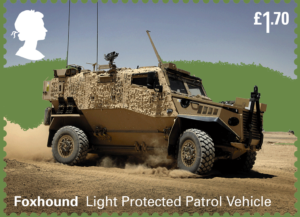 The Foxhound is a lightweight and fast patrol vehicle, with a maximum speed of 70mph. It has a V-shaped hull to channel the blast from mines or improvised explosive devices (IEDs) away from the underside of the vehicle. It has a crew of two and can carry up to four troops in the rear
The Foxhound is a lightweight and fast patrol vehicle, with a maximum speed of 70mph. It has a V-shaped hull to channel the blast from mines or improvised explosive devices (IEDs) away from the underside of the vehicle. It has a crew of two and can carry up to four troops in the rear
Miniature Sheet – Technical Details
Number of stamps: 4
Value of Stamps: 2 x 1st and 2 x £1.70
Design: Studio Up
Acknowledgements: Coyote photo © HOT SHOTS/Alamy Stock Photo; Army Wildcat, Foxhound and Trojan photos: UK MOD © UK Crown copyright 2021; Army logos are trade marks of the UK Secretary of State for Defence and used under licence
Sheet Size: 115mm x 89mm
Stamp Size: 41mm (w) x 30mm (h)
Printer : International Security Printers
Print Process: Lithography
Perforations: 14.5 x 14
Phosphor: Bars as appropriate
Gum: PVA
An authentic Ministry of Defence security hologram is affixed to the back of the envelope.
The First Day Cover is a unique time-limited and personalised collectible which includes all 8 British Army Vehicles stamps postmarked on their first day of issue – 2nd September 2021.
Customise your First Day Cover with your choice of two special edition British Army Vehicles postmarks.
Talents House postmark – Location: Tallents House, Edinburgh, Image: – Features a British army logo.
Alternative postmark – Location: Bovington, Wareham
Bovington is the location of The Tank Museum and, according to David Willey, still is the ‘home of the tank’ for the British Army.
The handstamp features an illustration of tank tracks.
You can even personalise your envelope with a name address of your choice making this an ideal collectible for yourself or a wonderful surprise gift for a friend or relative.
Inside the envelope is an information card with more details about the British Army Vehicles stamp issue
• Includes all eight British Army Vehicles Special Stamps
• Postmarked on the stamps’ first day of issue
• Personalised with name and address of customer’s choice
• Choice of 2 postmark designs
First Day Cover – Miniature Sheet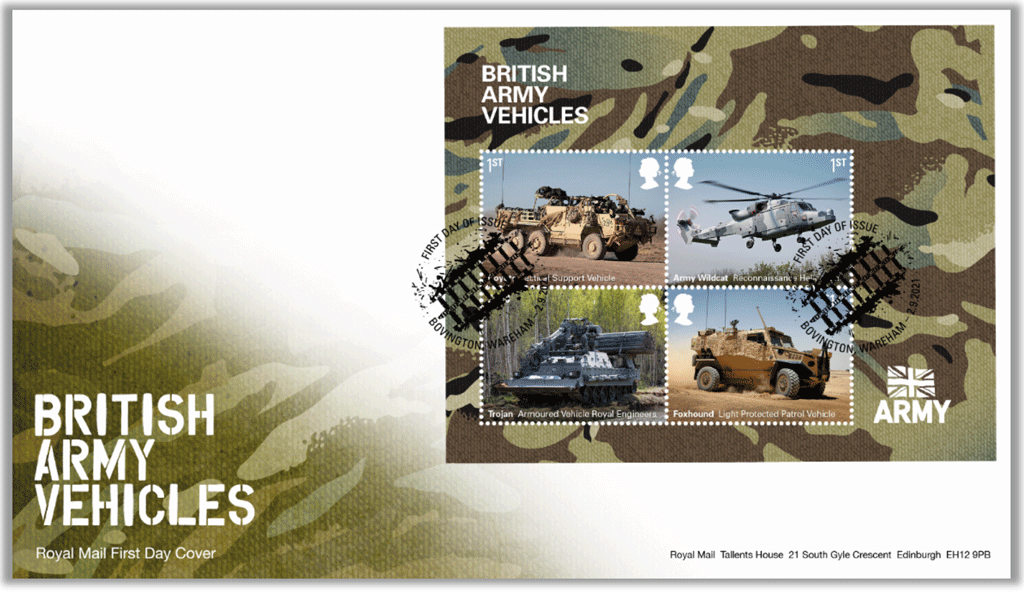
An authentic Ministry of Defence security hologram is affixed to the back of the envelope.
The First Day Cover is a unique time-limited and personalised collectible which includes all 4 British Army Vehicles miniature sheet stamps postmarked on their first day of issue – 2nd September 2021.
Customise your First Day Cover with your choice of two special edition British Army Vehicles postmarks.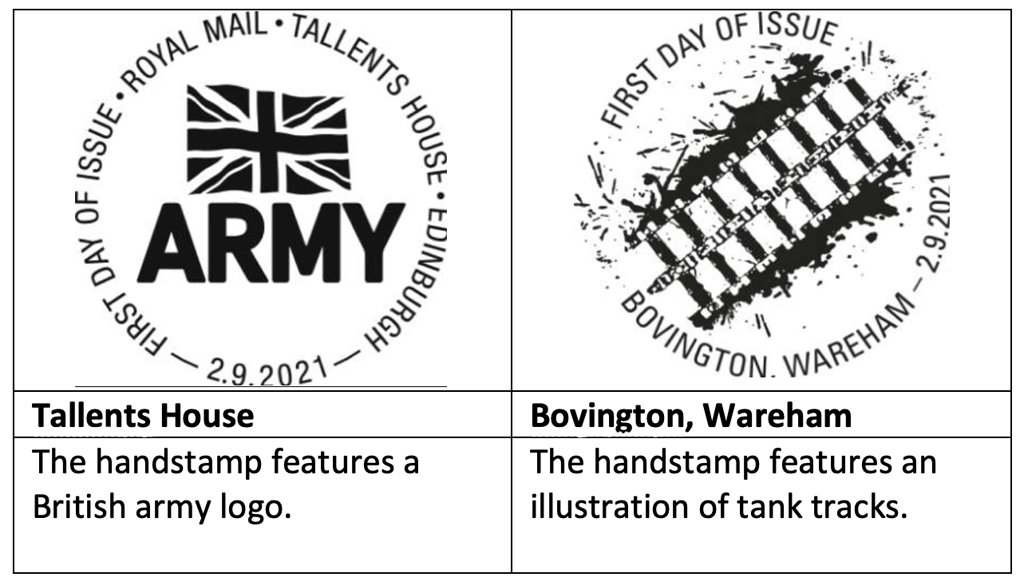
Talents House postmark – Location: Tallents House, Edinburgh. The handstamp features a British army logo.
Alternative postmark – Location: Bovington, Wareham
Bovington is the location of The Tank Museum and, according to David Willey, still is the ‘home of the tank’ for the British Army.
The handstamp features an illustration of tank tracks.
You can even personalise your envelope with a name address of your choice making this an ideal collectible for yourself or a wonderful surprise gift for a friend or relative.
Inside the envelope is an information card with more details about the British Army Vehicles stamp issue.
• Includes all four British Army Vehicles miniature sheet Special Stamps
• Postmarked on the stamps’ first day of issue
• Personalised with name and address of customer’s choice
• Choice of 2 postmark designs
Stamp Souvenirs
The Stamp Souvenir is a non-personalised version of the traditional First Day Cover, meaning it will not have the customer’s name and address printed on the front and will be available on sale for 3 months after the stamp issue date – until 2nd December 2021. The stamps are cancelled with the alternative Bovington, Wareham postmark.
An authentic Ministry of Defence security hologram is affixed to the back of the envelope.
FDC Postmarks
Customers can personalise their First Day cover with a choice of postmarks available. The alternative postmark location represents the Tank Museum in Bovington, Dorset.
An [unserviced] envelope featuring the issue title set against a camouflage pattern
Information Card (Filler Card)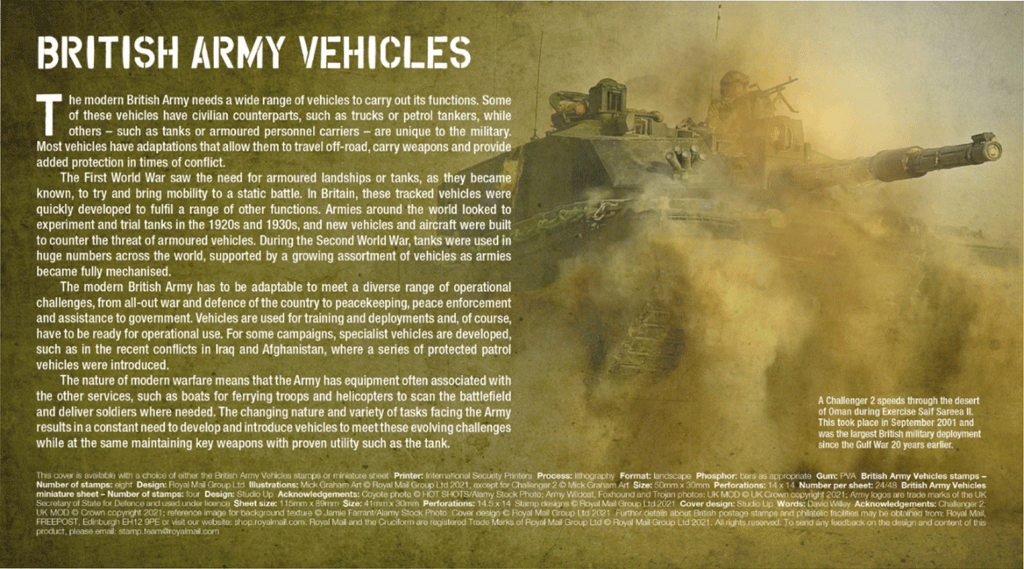 The information card is included inside the First Day Envelope, FDC and Stamp Souvenir and Stamp Sheet Souvenir. It provides a brief overview and specifications for the stamp issue. It was written by David Willey, Curator at the Tank Museum.
The information card is included inside the First Day Envelope, FDC and Stamp Souvenir and Stamp Sheet Souvenir. It provides a brief overview and specifications for the stamp issue. It was written by David Willey, Curator at the Tank Museum.
Emrick’s Palmer FDC Takes Cachet Honors
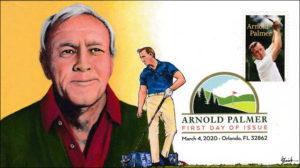 Emrick Cachets’ hand-painted/hand-drawn first day cover for the Arnold Palmer stamp took top honors as the best cachet of the year, in the American First Day Cover Society‘s annual cachetmakers contest. Bob Emrick‘s design was also the winner of the HP/HD category.
Emrick Cachets’ hand-painted/hand-drawn first day cover for the Arnold Palmer stamp took top honors as the best cachet of the year, in the American First Day Cover Society‘s annual cachetmakers contest. Bob Emrick‘s design was also the winner of the HP/HD category.
For the first time, a junior member of the AFDCS, 17-year-old Arianna Calle, won an adult category. In fact, Arianna won both first and second place in Category 3 Hand-Painted/Non-Original Art.
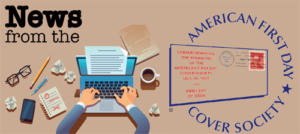 The results, announced at the President’s Banquet during Great American Stamp Show/Americover 2021, covered issues released during 2020. You can see all the winners here on The Virtual Stamp Club.
The results, announced at the President’s Banquet during Great American Stamp Show/Americover 2021, covered issues released during 2020. You can see all the winners here on The Virtual Stamp Club.
Emrick, who lives in a suburb of Dallas-Fort Worth, also creates hand-drawn pencil-sketch and printed cachets, all from original art. He also uses “the knowledge gained from a great career in commercial printing.” His printed covers make at least three passes through the printer which “creates a much fuller color gamut with deeper shadows and richer color,” he says. “I think the extra time and effort this requires is well worth the results.”
Bob was previously honored in the AFDCS Court of Honor in 2016, which each year features an outstanding cachetmaker’s work on a first day cover for the holiday issues. His first cachet was in 2005 for 50s Sporty Cars.
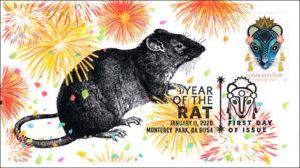 Arianna Calle is the daughter and granddaughter of professional artists Chris and Paul Calle, both of whom have designed U.S. stamps. Her covers have won first or second in the junior categories more than a dozen times previously, dating back to 2009. Her father Chris is also a past Top Cachet winner. [Arianna is shown below receiving her award from Contest Chair Rick Gibson, while AFDCS President Lloyd de Vries looks on.]
Arianna Calle is the daughter and granddaughter of professional artists Chris and Paul Calle, both of whom have designed U.S. stamps. Her covers have won first or second in the junior categories more than a dozen times previously, dating back to 2009. Her father Chris is also a past Top Cachet winner. [Arianna is shown below receiving her award from Contest Chair Rick Gibson, while AFDCS President Lloyd de Vries looks on.]
You can see the first- and second-place winners in each category here.
The AFDCS Cachetmakers Contest is held annually for the previous year’s issues, with 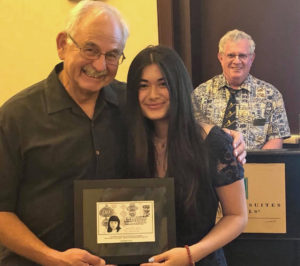 more than fifteen categories. Besides media and production methods, they include Foreign, Events, Esoteric and Rookie of the Year. Three anonymous judges, representing collectors, dealers, and artists judge each category, then choose the best of the best for the Top Cachet honor. The cachetmaker, by the way, is not eligible for Top Cachet the following year.
more than fifteen categories. Besides media and production methods, they include Foreign, Events, Esoteric and Rookie of the Year. Three anonymous judges, representing collectors, dealers, and artists judge each category, then choose the best of the best for the Top Cachet honor. The cachetmaker, by the way, is not eligible for Top Cachet the following year.
The Society publishes its award-winning journal First Days six times a year, as well as handbooks and directories, sponsors philatelic exhibit awards, advocates for FDC collecting and co-hosts the big national stamp collecting show each summer. The 2022 Great American Stamp Show will be held in Sacramento, Calif.
For more information on the AFDCS, visit its website www.afdcs.org, email afdcs@afdcs.org or write to the society at Post Office Box 246, Colonial Beach, VA 22443-0246.
U.S. Scott Catalogue Update (August 2021)
5598 (55¢) Sun Science – Coronal Hole
a. Imperforate
5599 (55¢) Sun Science – Coronal Loops
a. Imperforate
5600 (55¢) Sun Science – Solar Flare
a. Imperforate
5601 (55¢) Sun Science – Active Sun
a. Imperforate
5602 (55¢) Sun Science – Plasma Blast
a. Imperforate
5603 (55¢) Sun Science – Coronal Loops, diff.
a. Imperforate
5604 (55¢) Sun Science – Sunspots
a. Imperforate
5605 (55¢) Sun Science – Plasma Blast, diff.
a. Imperforate
5606 (55¢) Sun Science – Solar Flare, diff.
a. Imperforate
5607 (55¢) Sun Science – Coronal Hole, diff.
a. Imperforate
b. Block of 10, #5598-5607
c. Imperforate block of 10, #5598a-5607a
5608 (55¢) Yogi Berra
a. Imperforate
5609 (55¢) Tap Dance – Max Pollak (buff “TAP”)
a. Imperforate
5610 (55¢) Tap Dance – Michela Marino Lerman (rose “TAP”)
a. Imperforate
5611 (55¢) Tap Dance – Derick Grant (greenish blue “TAP”)
a. Imperforate
5612 (55¢) Tap Dance – Dormeshia Sumbry-Edwards (light blue “TAP”)
a. Imperforate
5613 (55¢) Tap Dance – Ayodele Casel (bister “TAP”)
a. Imperforate
b. Horiz. strip of 5, #5609-5613
c. Imperforate horiz. strip of 5, #5609a-5613a
5614 (55¢) Mystery Message
a. Imperforate
RW88 $25 Lesser scaup Hunting Permit Stamp, self-adhesive
RW88A $25 Lesser scaup Hunting Permit Stamp, self-adhesive, souvenir sheet of 1

